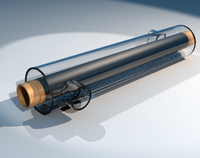
Photo from wikipedia
The present work aims at the thermodynamic analysis of different working pairs in adsorption heat transformers (AdHT) for low-temperature waste heat upgrade in industrial processes. Two different AdHT configurations have… Click to show full abstract
The present work aims at the thermodynamic analysis of different working pairs in adsorption heat transformers (AdHT) for low-temperature waste heat upgrade in industrial processes. Two different AdHT configurations have been simulated, namely with and without heat recovery between the adsorbent beds. Ten working pairs, employing different adsorbent materials and four different refrigerants, have been compared at varying working boundary conditions. The effects of heat recovery and the presence of a temperature gradient for heat transfer between sinks/sources and the AdHT components have been analyzed. The achieved results demonstrate the possibility of increasing the overall performance when internal heat recovery is implemented. They also highlight the relevant role played by the existing temperature gradient between heat transfer fluids and components, that strongly affect the real operating cycle of the AdHT and thus its expected performance. Both extremely low, i.e., 40–50 °C, and low (i.e., 80 °C) waste heat source temperatures were investigated at variable ambient temperatures, evaluating the achievable COP and specific energy. The main results demonstrate that optimal performance can be achieved when 40–50 K of temperature difference between waste heat source and ambient temperature are guaranteed. Furthermore, composite sorbents demonstrated to be the most promising adsorbent materials for this application, given their high sorption capacity compared to pure adsorbents, which is reflected in much higher achievable specific energy.
Journal Title: Applied Sciences
Year Published: 2021
Link to full text (if available)
Share on Social Media: Sign Up to like & get
recommendations!